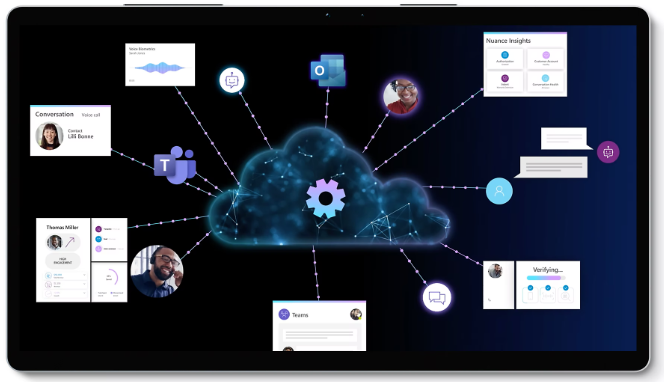How leveraging AI can drive efficiencies within your business through a. MicrosoftTeams Contact Centre
“Can I put you on hold for a minute while I speak to my supervisor?”
And then you wait…with Greensleeves hold music on repeat, frustration levels increasing and your satisfaction with the interaction plummeting.
We’ve come a long way since the contact centre days of old. It’s this exact scenario where AI is transforming the modern contact centre, and all for the better.

How AI services are changing the face of modern Contact Centres
According to McKinsey’s State of Customer Care Survey 2022, 61% of surveyed care leaders reported a growth in total calls, with increased contacts per customer and a growing customer base as the key drivers. 58% of them expect call volumes to increase even further over the next 18 months. And they’re having to handle these increases with reduced resources and while shifting to a remote agent model. Modern contact centres can, and should, use AI services to add genuine value and address these pressing challenges. Being able to do more with less is the name of the game.
But how?
The most obvious route is by enabling the self-serve of information to callers and to staff, automating the parts of a customer interaction where human intervention isn’t necessary and making the experience better for everyone. There’s no need to call in a supervisor and keep a customer on hold – AI has already recognised that things aren’t going to plan and the supervisor is already involved. No going on hold. No frustrated wait. No disconnect with the agent.
AI isn’t just an IVR, or just reporting or an agent interface, it’s a combination of all of the above – and more. And many organisations are yet to think about these things at all, or if they are, not quite enough. The value add of a modern contact centre is all about improvement, making the lives of your agents better and enhancing their work experience – which ultimately leads to enhancing your customer experience.
A recent Microsoft Work Trend Index Annual Report showed that “While 49% of people say they’re worried AI will replace their jobs, even more – 70% – would delegate as much work as possible to AI to lessen their workloads.”
It’s all about using AI to empower your workforce to deliver an improved, enhanced service – not replacing them altogether.
Some example use cases for AI services within Microsoft Teams Contact Centres
Natural language processing and sentiment analysis mean that a call or dialogue with someone in an organisation using advanced AI services can recognise when a call isn’t going to plan and can automatically invite someone else to support that member of staff, and thereby support that customer.
Advances in technology mean that language detection is now possible. If, for example, you’re in the UK and are not a native English speaker, Azure services can now recognise the language being used, translate it and even provide a written transcription.
Intention analysis can recognise what a caller is interested in and can direct them to the most appropriate resolution. The evolution of IVRs demonstrates this – where depending on whether a caller is looking for advice, feedback, to complain or cancel, they can automatically be directed to an agent in the corresponding department.
The data entry days of 10-20 years ago are over – for example, CSAT data capture has also been transformed. Historically a caller would need to complete a form to state their level of customer satisfaction. But capturing client satisfaction has become much easier thanks to AI – call transcription means the CX piece can be done on the fly. AI understands from the way a caller has spoken and what has been said if the call was a positive one.
How to approach the design and integration of AI services
Approaching AI is all about challenging how your organisation works now – understanding where you are, your customer journey and gaining meaningful insights into what works for your business – and then re-evaluating what you need and how you can leverage AI to design and integrate with your existing systems.
Most of our customers used to have a lift & shift approach – issue a tender, make a decision on a solution, deploy the solution, do a little training and then follow up with some support. But in the last 12-18 months I’ve noticed that rather than AI being just a buzzword within a tender, it has become embedded in the process and is considered an integral part of it. There is now a genuine focus on how AI may be used to drive efficiency and transform the business.
Key to all of this choosing the right technology partner, one that aligns with both your short and long term business goals, and your vision for customer experience – and has the expertise you need to design and deliver the right solution. As one of the world’s most experienced and efficient enabler of complex Microsoft Teams Phone, Contact Centre and Microsoft Teams Rooms, I’d like to think that choosing Symity is a no-brainer. Our approach is always to be honest about the technology you need and then take the time to ensure your people understand how to get the most from it, delivering an end-to-end, value-driven solution that works harder and smarter for you.
To find out more how Symity can help you to implement more AI into your contact centre features, get in touch.

Chris Goodwill
Strategic Partner Manager and Solution Specialist
Symity